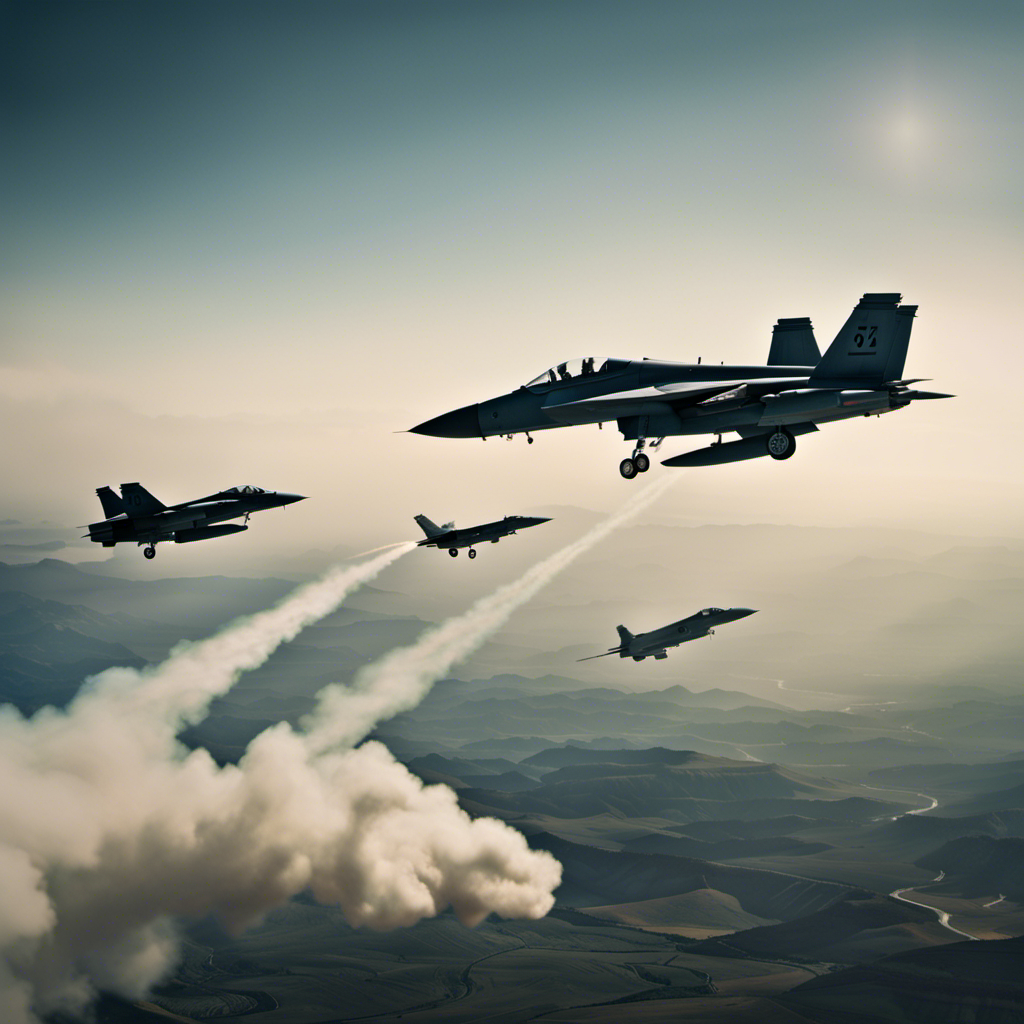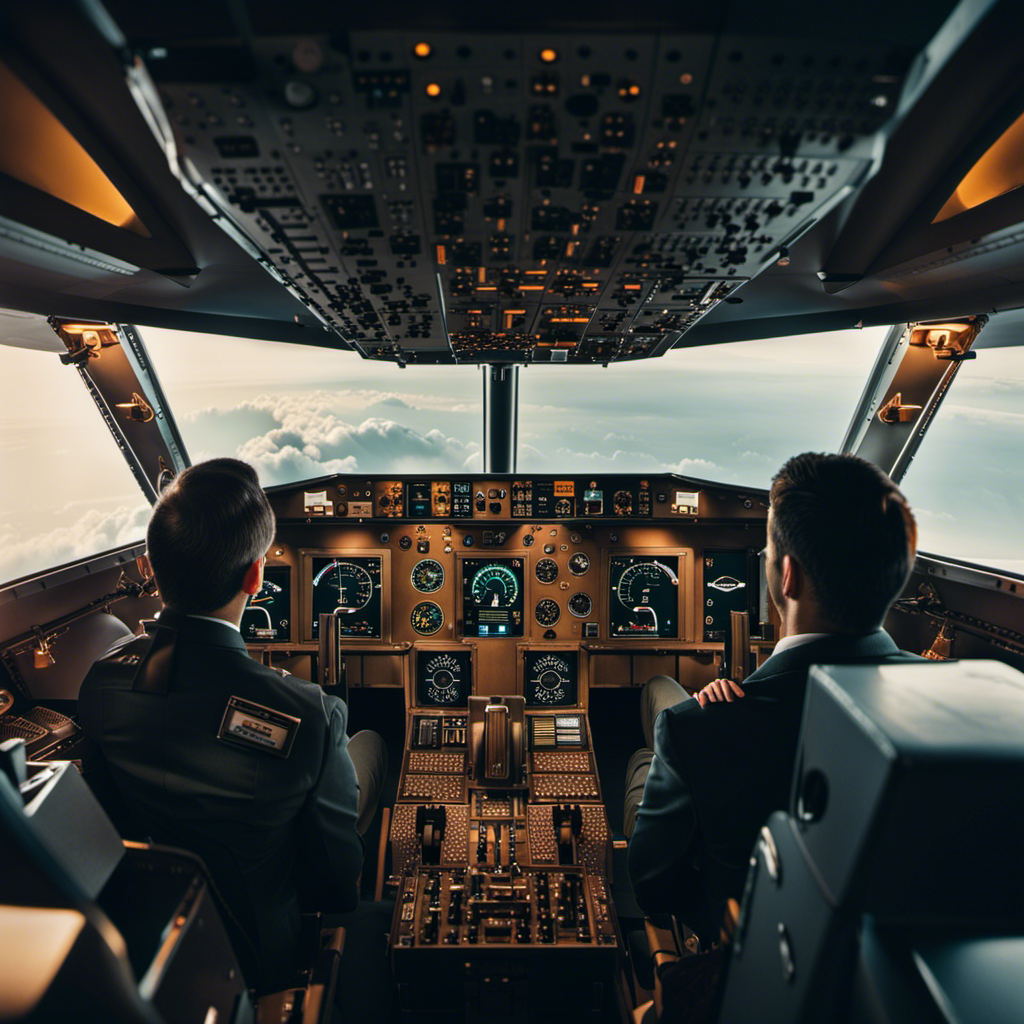As a pilot, I have frequently heard the saying ‘third time’s the charm.’ However, when it comes to ejecting from an aircraft, is there truly a limit? This article delves into the fascinating history and technology of ejection systems.
We’ll also explore the factors that can limit the number of ejections and debunk the myth that pilots can only eject twice. Join me on this journey as we uncover the truth behind this widely believed notion and shed light on the real-life examples of multiple ejections that have occurred.
Key Takeaways
- Ejection systems have been used by pilots for almost a century and are an essential safety feature in modern military aircraft.
- Altitude and airspeed greatly impact the effectiveness of ejections, and proper operation and maintenance of the ejection system are crucial.
- The myth that pilots can only eject twice is debunked, as advancements in technology have increased the potential for multiple ejections.
- Real-life examples, such as Lt. Col. William Rankin and Capt. Scott O’Grady, highlight the effectiveness of ejection systems, but failures can still occur, emphasizing the need for training and maintenance.
The History of Ejection Systems
Did you know that ejection systems have been used by pilots for almost a century?
The history of ejection systems dates back to the early 1920s when various inventors began developing mechanisms to safely eject pilots from disabled aircraft. One of the earliest successful designs was created by Romanian inventor Anastase Dragomir in 1929.
Since then, ejection systems have undergone significant development and refinement. They have become an essential safety feature in modern military aircraft, allowing pilots to escape from dangerous situations such as engine failures, structural failures, or enemy attacks.
The continuous development of ejection systems has greatly improved the chances of pilot survival in emergency situations.
Now, let’s delve into how ejection systems work, without getting into the technical details.
How Ejection Systems Work
Wondering how ejection systems work? Well, you might be surprised by the fascinating mechanics behind them! Ejection seat design has come a long way since its inception, and today’s systems are highly sophisticated and reliable. Here’s a breakdown of how they function:
- Seat Initiation: When the pilot pulls the ejection handle, it triggers a series of events.
- Rocket Motor Ignition: A powerful rocket motor fires, propelling the seat and pilot upwards.
- Canopy Jettison: Simultaneously, explosive charges blow off the canopy, ensuring a clear path for the pilot.
- Parachute Deployment: Once clear of the aircraft, the seat deploys a parachute, allowing for a safe descent to the ground.
Understanding these emergency procedures is crucial for pilots, as it can mean the difference between life and death in a dire situation. However, there are factors that can limit the number of ejections a pilot can safely undergo.
Factors That Can Limit the Number of Ejections
Understanding the factors that can limit how many times you can safely eject is crucial for your safety as a pilot. There are several key factors that can affect the effectiveness of an ejection system.
Firstly, the altitude and airspeed at which you eject can greatly impact the outcome. Higher altitudes and faster speeds can increase the risk of injury upon ejection.
Secondly, the proper operation of the ejection system itself is essential. Regular maintenance and inspections are necessary to ensure its functionality.
Lastly, the training requirements for ejection system usage play a vital role. Pilots must undergo rigorous training to understand the correct procedures and techniques for safe ejections.
The Myth of Two Ejections
To debunk the myth of two ejections, you should be aware that the number of times you can safely eject is not limited to a fixed amount. Ejection seat maintenance plays a crucial role in ensuring the safety and effectiveness of ejections. Regular inspections and repairs are conducted to keep the ejection seats in optimal condition. Additionally, advancements in technology have led to the development of more reliable and durable ejection systems, further increasing the potential for multiple ejections.
It is also important to consider the psychological effects of ejection on pilots. While ejections can be physically demanding and traumatic experiences, proper training and support can help pilots cope with the psychological impact. Understanding these factors, it becomes clear that the belief in a strict limit of two ejections is unfounded.
Moving on to real-life examples of multiple ejections…
Real-Life Examples of Multiple Ejections
If you’re curious about real-life examples of pilots who have experienced multiple ejections, there are several notable cases that demonstrate the effectiveness of ejection systems.
In real life incidents, pilots have faced situations where their aircraft was damaged or malfunctioning, forcing them to eject more than once.
One such case is that of Lt. Col. William Rankin, who ejected from his F-8 Crusader at a high altitude after a severe thunderstorm caused his aircraft to lose power.
Another example is Capt. Scott O’Grady, who ejected from his F-16 fighter jet in Bosnia after being shot down by a surface-to-air missile.
These incidents highlight the importance of ejection systems in saving lives during emergencies. However, it is essential to note that ejection system failures can occur, underscoring the need for proper ejection training and maintenance.
The Importance of Ejection Training
Proper ejection training is crucial for ensuring the safety of pilots in emergency situations. It not only equips them with the necessary skills to eject from an aircraft but also prepares them for the psychological effects of such a traumatic event. Ejection training techniques have evolved over the years to provide pilots with the best chance of survival.
Some key elements of ejection training include:
- Understanding the ejection system: Pilots must be familiar with the components and operation of their aircraft’s ejection system.
- Physical conditioning: Maintaining physical fitness is essential to withstand the tremendous forces experienced during ejection.
- Simulation and practice: Regular training exercises allow pilots to become familiar with the ejection process and build muscle memory.
Proper ejection training can help pilots overcome the initial shock and disorientation of an emergency ejection. This transition to the subsequent section about advances in ejection system technology highlights the importance of continuous improvement in ensuring pilot safety.
Advances in Ejection System Technology
Advances in ejection system technology have significantly increased the chances of pilot survival during emergency situations. The continuous development in ejection seat design and advancements in ejection system materials have brought about significant improvements in pilot safety.
Modern ejection seats are equipped with advanced features such as enhanced stability, improved head and neck protection, and increased maneuverability. These advancements have not only made ejection seats more efficient but have also reduced the risk of injury during ejection.
The use of lightweight yet strong materials has allowed for the creation of seats that can withstand high-speed ejections and extreme conditions. Such advancements in ejection system technology are crucial in ensuring the safety and survival of pilots in critical situations.
Moving forward, it is important to consider additional safety measures for pilots to further enhance their chances of survival.
Safety Measures for Pilots
To ensure your safety as a pilot, it is essential to familiarize yourself with proper safety measures and procedures. Here are four important aspects to consider when it comes to pilot safety:
-
Training protocols: As a pilot, it is crucial to undergo comprehensive training that covers emergency procedures and ejection system operation. This training ensures that you are well-prepared to handle any potential emergency situation.
-
Ejection system maintenance: Regular maintenance of ejection systems is vital to ensure their proper functioning. Pilots should follow the recommended maintenance schedules and guidelines provided by the aircraft manufacturer to keep the ejection systems in optimal condition.
-
Pre-flight checks: Before every flight, pilots should conduct thorough pre-flight checks, including inspecting the ejection system and verifying that all components are in working order. This step helps identify any potential issues and ensures the system is ready for use if needed.
-
Continuous learning: Staying up-to-date with the latest safety procedures and advancements in ejection system technology is crucial. Attend regular safety training sessions and stay informed about any updates or changes to the procedures.
Understanding these safety measures and following them diligently can significantly contribute to your overall safety as a pilot.
Now, let’s delve into the different types of ejection systems in aircraft without further ado.
Ejection Systems in Different Types of Aircraft
When flying different types of aircraft, it’s important to understand the functioning of ejection systems and how they vary across various models and designs. Ejection seat design plays a critical role in pilot safety during emergency situations. These seats are meticulously engineered to provide a controlled ejection sequence, ensuring the pilot’s survival.
The ejection system consists of various components, including the seat, canopy jettison mechanism, and parachute deployment system. Regular ejection system maintenance is crucial to ensure its proper functioning. This includes inspections, replacement of worn-out parts, and testing to guarantee reliable performance when needed.
Understanding the intricacies of ejection seat design and diligently maintaining the ejection system are essential for pilot safety. With this knowledge, we can now delve into the role of ejection seats in pilot survival.
The Role of Ejection Seats in Pilot Survival
Understanding the intricacies of ejection seat design and diligently maintaining the ejection system are essential for ensuring pilot safety and survival in emergency situations. Ejection seats are a critical component of modern aircraft, designed to provide a means of escape when all other options have failed.
The effectiveness of ejection seats is evident in pilot rescue operations, where these systems have saved countless lives. By rapidly propelling the pilot out of the aircraft, ejection seats minimize the risk of injury during high-speed ejections. Furthermore, they are equipped with parachutes and survival kits to increase the chances of survival after ejection.
These systems undergo rigorous testing and regular maintenance to ensure their reliability. It is crucial to recognize the importance of ejection seat effectiveness in pilot rescue operations before addressing common misconceptions about ejection systems.
Common Misconceptions About Ejection Systems
One common misconception about ejection systems is that they are only used in life-or-death situations. While it is true that ejection systems are primarily designed to save the lives of pilots in emergency situations, they also serve other important purposes.
Ejection systems consist of various components, including the ejection seat, parachute, and survival gear. These components require regular maintenance and inspection to ensure their proper functioning. Ejection system maintenance involves checking for any signs of wear and tear, replacing expired components, and conducting thorough testing.
By regularly maintaining ejection systems, the risks of malfunctions and failures can be minimized, ultimately increasing the chances of pilot survival in critical situations.
Looking ahead, the future of ejection systems holds exciting advancements in technology, such as improved escape capsules and enhanced safety features, which will further enhance pilot safety and survival rates.
The Future of Ejection Systems
To fully grasp the potential of ejection systems in the future, imagine how they can greatly enhance your safety and survival as a pilot.
Future developments in ejection systems hold immense promise, as they aim to address the challenges faced by current systems and introduce advancements that can revolutionize aviation safety.
One key area of focus is the improvement of ejection seat technology to accommodate a wider range of pilot physiologies and ensure optimal protection during ejection.
Additionally, there is ongoing research into the development of advanced parachute systems and technologies that can enhance the overall survivability of pilots in emergency situations.
These advancements are crucial in mitigating the risks associated with ejection and ensuring the highest level of safety for pilots.
As we delve further into the role of ejection systems in aviation safety, we will explore their effectiveness in emergency situations and the measures in place to ensure their reliability.
The Role of Ejection Systems in Aviation Safety
Ejection systems play a crucial role in ensuring the safety of pilots during emergency situations. These systems are designed to rapidly eject the pilot from the aircraft in the event of an impending disaster, such as a mid-air collision or mechanical failure. The effectiveness of ejection systems depends on various factors, including the speed of ejection, the altitude at which the ejection occurs, and the proper execution of pilot ejection procedures.
To illustrate the importance of ejection systems, consider the following table:
| Factor | Ejection System Effectiveness |
|---|---|
| Speed of Ejection | Rapid ejection reduces the risk of injury or death for the pilot. |
| Altitude of Ejection | Higher altitudes provide more time for the parachute to deploy properly. |
| Pilot Ejection Procedures | Proper execution of ejection procedures increases the chances of a successful ejection. |
Understanding these factors is essential for maximizing the safety benefits of ejection systems. Without proper training and adherence to protocols, the effectiveness of these systems may be compromised.
Transitioning into the subsequent section about ‘the impact of ejection systems on pilot confidence,’ it is important to note that while ejection systems are crucial for pilot safety, their use can also have psychological effects on pilots.
The Impact of Ejection Systems on Pilot Confidence
While ejection systems are designed to ensure pilot safety, they can also have psychological effects on the confidence of pilots. Pilot psychology plays a crucial role in aviation, and the reliability of ejection systems can significantly impact their state of mind.
Knowing that there is a system in place to save them in case of emergencies provides a sense of security and reassurance. However, if pilots start questioning the reliability of the ejection system, it can lead to a decrease in their confidence. Doubts about the system’s effectiveness may cause pilots to hesitate during critical moments, potentially jeopardizing their safety.
Understanding the psychological impact of ejection systems is essential to address any concerns and ensure pilots maintain their confidence in the equipment. With this in mind, it is important to debunk the myth surrounding the idea that pilots can only eject twice, as it further contributes to unnecessary anxiety and undermines their trust in the ejection system.
Conclusion: Debunking the Myth of Two Ejections
Remember, it’s important to debunk the myth of two ejections to alleviate unnecessary anxiety and maintain trust in the ejection system. The truth about ejection limitations is that there is no fixed number of times a pilot can eject from an aircraft. The ejection system’s purpose is to save lives in emergency situations, and it is designed to be reliable and effective. Here are some key points to consider:
- Ejection systems are thoroughly tested and certified to ensure their reliability and safety.
- The number of ejections a pilot can perform depends on various factors, such as the aircraft type, maintenance, and individual circumstances.
- Each ejection is evaluated on a case-by-case basis, taking into account the specific situation and condition of the pilot.
Debunking ejection system myths is crucial for pilots to have confidence in their safety equipment. It is essential to trust in the expertise and technology behind these systems, which are continuously evolving to provide the best possible protection for pilots.
Frequently Asked Questions
How many ejections can a pilot typically survive?
A pilot’s ability to survive ejections depends on various factors, such as the ejection system limitations and the specific circumstances of each ejection. It is crucial to consider these factors when discussing pilot ejection survivability.
What factors can cause ejection systems to fail?
Oh, the joys of ejection system malfunctions! When these delightful little mishaps occur, the consequences of ejection system failure can be quite…explosive, to say the least.
Are there any alternative methods for pilots to escape from a crashing aircraft?
Alternative escape methods for pilots include using ejection seats, emergency parachutes, and evacuation slides. These methods can increase the pilot survival rate in the event of a crashing aircraft, providing additional options for escape and survival.
What are the safety measures in place to prevent accidental ejections?
Safety measures are in place to prevent accidental ejections. Multiple redundant mechanisms, such as rigorous pre-flight inspections, secure locking systems, and fail-safe release mechanisms, ensure that ejections only occur when absolutely necessary, minimizing the risk of accidental ejections.
How has ejection system technology advanced over the years?
Ejection seat design and materials have significantly advanced over the years. Improved technology has led to lighter and more compact ejection seats, enhanced safety features, and increased reliability, ensuring pilots have a higher chance of survival during emergencies.
Conclusion
In conclusion, the myth that pilots can only eject twice is just that – a myth. Through the history and science of ejection systems, we have debunked this misconception.
Real-life examples have shown that pilots can eject multiple times, and the future of ejection systems holds even more advancements in safety.
Ejection systems play a crucial role in aviation safety, instilling confidence in pilots. So let us soar through the skies, knowing that like the phoenix, pilots can rise again and again, protected by the marvels of ejection technology.
With a heart that soars as high as the skies, Aria, affectionately known as “Skylark,” is the driving force behind Soaring Skyways. Her journey into the gliding world began as a young dreamer gazing up at the soaring birds, yearning to experience the weightlessness and freedom they embodied. With years of experience both in the cockpit and behind the scenes, Aria’s commitment to the gliding community is unwavering.










